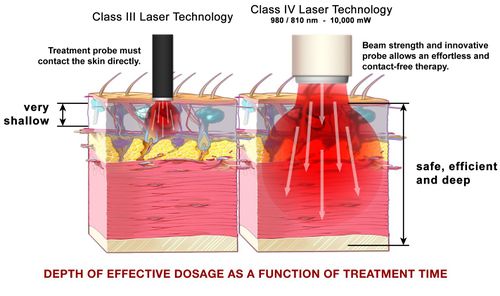High Power Laser Therapy
Introduction[edit | edit source]
LASER means Light Amplification from Stimulated Emission of Radiation. Laser is created by specific process within the laser device to cause the controlled emission of radiation in form of light.Lasers were first invented by physicist Gordon Gould in 1958 and first working model was built in 1960.They have been used in Europe and America for more than forty years and have been used in fields of dermatology, surgery. ophthalmology and physical medicine and rehabilitation. Laser is used by physiotherapists for relief of pain, to accelerate healing and decrease inflammation.
Difference between Low Level Laser Therapy and High Power Laser Therapy[edit | edit source]
An output power of less than 0.5 Watts is classed as Low Level Laser Therapy LLLT ( class III in the USA) whereas lasers with an output powers
greater than 500 mW or
0.5 Watts are termed High Power Laser Therapy HPLT (Class IV lasers in the USA). HPLT creates heat on the surface of the skin due to their higher power
density (irradiance). LLLT is often referred to as “Cold Lasers” since they do not create a heating sensation during treatment.[1]
Production of Laser[edit | edit source]
Laser device is made up of an optical cavity or chamber that contains active medium for which laser is named.The chamber has mirrors on either end that are perfectly parallel to each other within a single wavelength of light.One of the mirror is partially open. Electricity or energy is added to the medium which excites it.The active mediums atoms are reflected back and forth across the mirrors within the chambers.this causes more excitation of atoms within the medium. Laser light is then emitted through the partially reflective end of mirror.The light production occurs in the following steps:
1.Electron is pumped to a higher energy level.
2.Pumping level is unstable so the electron quickly jumps to a slightly lower energy level.
3.Electron relaxes to a lower energy state and releases a photon.
4.Light and an electron in an excited energy level produces two photons of same wavelength and phase.
5.Mirror reflects the photons or laser light is emitted.
Properties of Laser[edit | edit source]
Due to specific nature of how laser is produced it also has specific properties;
1.Monochromatic - Monochromaticity refers to the colour or wavelength of the light. Since laser is produced from a single active medium laser light it is of single colour, one wavelength.
2.Coherent and Parallel- Due to common wavelength of laser light ,the phase of each wave is also common. Light travels in sine waves in phase relationship with one another with peak and valleys precisely coinciding and reinforcing each other so laser light travels as parallel beam spreading very little.
How does Laser Work[edit | edit source]
When the light source is placed against the skin, the photons penetrates several centimetres and gets absorbed by the mitochondria. The energy fuels many positive physiological responses resulting in restoration of normal cell morphology and function but at enhanced rate.Targeted in haemoglobin and cytochrome oxidase, the high power diode laser could help in respiration and then in result have a good performance therapy.[2]
Physiotherapy[edit | edit source]
Physiotherapists use HPLT basically on the presumption that energised cells from the laser increase the rate of healing.
Class IV hot laser therapy (high intensity laser therapy) can treat a variety of conditions, such as:
- Osteoarthritis of the knee, hip and ankle
- Rheumatoid arthritis
- Shoulder impingement syndromes
- Hip or shoulder bursitis
- Low back disc degeneration
- Disc herniation
- Sciatica
- Tendonitis
- Tennis elbow
- Plantar fasciitis
Evidence[edit | edit source]
The results of 2018 study entitled "Effectiveness of high-intensity laser therapy in the treatment of musculoskeletal disorders. A systematic review and meta-analysis of randomized controlled trials" concluded that HILT treatment for back and neck pain significantly improved pain and disability scores compared with controls. It also commented that additional well-designed studies involving larger samples with long-term follow-up were needed to further assess each laser application, treatment region, and comparator.[4]
A 2017 review titled "Effective treatment options for musculoskeletal pain in primary care: A systematic overview of current evidence" concluded that the evidence on effectiveness of laser therapy for shoulder pain or acute or chronic neck pain was inconclusive. With regards to knee pain low level laser therapy may confer added benefits to exercise and / or surgical treatment. [5]
References[edit | edit source]
- ↑ Rehab Management Treating Pain with Low vs High-Power Lasers: What is the Difference? Published on April 4, 2019 Available from: http://www.rehabpub.com/2019/04/treating-pain-low-vs-high-power-lasers-difference/ (last accessed 24.6.2019)
- ↑ Lasers in Physical Therapy 10.10.2012 Laser Available from: http://www.mccc.edu/~behrensb/documents/LasersinPhysicalTherapy2012.pdf (last accessed 24.6.2019)
- ↑ BTLmedical High Intensity Laser - Medical Effects Available from: https://www.youtube.com/watch?v=kn7JXDGpEfI (last accessed 24.6.2019)
- ↑ Song HJ, Seo HJ, Lee Y, Kim SK. Effectiveness of high-intensity laser therapy in the treatment of musculoskeletal disorders: A systematic review and meta-analysis of randomized controlled trials. Medicine. 2018 Dec;97(51). Available from: https://www.ncbi.nlm.nih.gov/pmc/articles/PMC6319951/ (last accessed 24.6.2019)
- ↑ Babatunde OO, Jordan JL, Van der Windt DA, Hill JC, Foster NE, Protheroe J. Effective treatment options for musculoskeletal pain in primary care: A systematic overview of current evidence. PloS one. 2017 Jun 22;12(6):e0178621. Available from: https://www.ncbi.nlm.nih.gov/pmc/articles/PMC5480856/ (last accessed 24.6.2019)







